Dynamics of Brassinosteroid Response Modulated by Negative Regulator LIC in Rice
Brassinosteroids (BRs) regulate rice plant architecture, including leaf bending, which affects grain yield. Although BR signaling has been investigated in Arabidopsis thaliana, the components negatively regulating this pathway are less well understood. Here, we demonstrate that Oryza sativa LEAF and TILLER ANGLE INCREASED CONTROLLER (LIC) acts as an antagonistic transcription factor of BRASSINAZOLE-RESISTANT 1 (BZR1) to attenuate the BR signaling pathway. The gain-of-function mutant lic-1 and LIC–overexpressing lines showed erect leaves, similar to BZR1–depleted lines, which indicates the opposite roles of LIC and BZR1 in regulating leaf bending. Quantitative PCR revealed LIC transcription rapidly induced by BR treatment. Image analysis and immunoblotting showed that upon BR treatment LIC proteins translocate from the cytoplasm to the nucleus in a phosphorylation-dependent fashion. Phosphorylation assay in vitro revealed LIC phosphorylated by GSK3–like kinases. For negative feedback, LIC bound to the core element CTCGC in the BZR1 promoter on gel-shift and chromatin immunoprecipitation assay and repressed its transcription on transient transformation assay. LIC directly regulated target genes such as INCREASED LEAF INCLINATION 1 (ILI1) to oppose the action of BZR1. Repression of LIC in ILI1 transcription in protoplasts was partially rescued by BZR1. Phenotypic analysis of the crossed lines depleted in both LIC and BZR1 suggested that BZR1 functionally depends on LIC. Molecular and physiology assays revealed that LIC plays a dominant role at high BR levels, whereas BZR1 is dominant at low levels. Thus, LIC regulates rice leaf bending as an antagonistic transcription factor of BZR1. The phenotypes of lic-1 and LIC–overexpressing lines in erect leaves contribute to ideal plant architecture. Improving this phenotype may be a potential approach to molecular breeding for high yield in rice.
Published in the journal:
Dynamics of Brassinosteroid Response Modulated by Negative Regulator LIC in Rice. PLoS Genet 8(4): e32767. doi:10.1371/journal.pgen.1002686
Category:
Research Article
doi:
https://doi.org/10.1371/journal.pgen.1002686
Summary
Brassinosteroids (BRs) regulate rice plant architecture, including leaf bending, which affects grain yield. Although BR signaling has been investigated in Arabidopsis thaliana, the components negatively regulating this pathway are less well understood. Here, we demonstrate that Oryza sativa LEAF and TILLER ANGLE INCREASED CONTROLLER (LIC) acts as an antagonistic transcription factor of BRASSINAZOLE-RESISTANT 1 (BZR1) to attenuate the BR signaling pathway. The gain-of-function mutant lic-1 and LIC–overexpressing lines showed erect leaves, similar to BZR1–depleted lines, which indicates the opposite roles of LIC and BZR1 in regulating leaf bending. Quantitative PCR revealed LIC transcription rapidly induced by BR treatment. Image analysis and immunoblotting showed that upon BR treatment LIC proteins translocate from the cytoplasm to the nucleus in a phosphorylation-dependent fashion. Phosphorylation assay in vitro revealed LIC phosphorylated by GSK3–like kinases. For negative feedback, LIC bound to the core element CTCGC in the BZR1 promoter on gel-shift and chromatin immunoprecipitation assay and repressed its transcription on transient transformation assay. LIC directly regulated target genes such as INCREASED LEAF INCLINATION 1 (ILI1) to oppose the action of BZR1. Repression of LIC in ILI1 transcription in protoplasts was partially rescued by BZR1. Phenotypic analysis of the crossed lines depleted in both LIC and BZR1 suggested that BZR1 functionally depends on LIC. Molecular and physiology assays revealed that LIC plays a dominant role at high BR levels, whereas BZR1 is dominant at low levels. Thus, LIC regulates rice leaf bending as an antagonistic transcription factor of BZR1. The phenotypes of lic-1 and LIC–overexpressing lines in erect leaves contribute to ideal plant architecture. Improving this phenotype may be a potential approach to molecular breeding for high yield in rice.
Introduction
Brassinosteroids (BRs) are plant steroid hormones that have been used to increase the yield of crops [1], [2]. BRs function in multiple developmental and physiological processes, including vascular differentiation, reproductive development, photomorphogenesis, and stress responses [3]–[5]. BR-deficient and -insensitive mutants show dwarfism, dark-green leaves, reduced fertility, and altered photomorphogenesis in the dark [6]–[9]. In rice (Oryza sativa), leaf-angle response to BRs is a specific physiological process. For example, the erect leaves of BR-deficient rice allow for greater growth density and higher grain yield [10]. Thus, analysis of genes involved in rice BR signaling could shed light on the molecular mechanisms of BR-regulated growth in monocots and help identify feasible approaches to increase rice yield by genetic engineering.
The BR signaling pathway has been well studied in Arabidopsis. Most of the signaling components of this pathway, from the BR receptor BRI1 and co-receptor BAK1 to nuclear transcription factors BZR1 and BES1/BZR2, have been identified [11], [12]. During the early events of BR signaling, BRI1 perceives BRs, thus inducing dissociation of the inhibitory protein BKI1, which results in association with and transphosphorylation of the co-receptor BAK1 [13]–[17]. BR signal kinases (BSKs) mediate signal transduction from BRI1 to BSU1 phosphatase through association with and phosphorylation of BSU1 [18]. BSU1 positively regulates BR signaling by dephosphorylating the negative regulator BR-insensitive 2 (BIN2). This process facilitates accumulation of unphosphorylated BZR1 and BES1/BZR2 in the nucleus [19]–[23], which directly or indirectly activate the expression of BR-responsive genes and regulate plant growth [21], [24], [25]. BZR1 is also responsible for the negative feedback of BR biosynthetic genes such as CPD by directly repressing transcription [26]. BZR1 and BES1 are major transcription factors in the BR signaling pathway [27]. BZR1 binds to the BR-responsive element (BRRE, CGTGT/CG) and mainly represses gene expression. BES1 binds to E-box by interacting with BIM1 or MYB30 to promote target gene expression [28]–[30]. BZR1 could also bind to E-box and BES1 to BRRE, so the functions of the family members may overlap [31], [32]. These are key transcription factors activating the BR signaling pathway in plants. Phosphatase 2A (PP2A) dephosphorylates BZR1 and also BRI1 in mediating BR signaling. BRI1 degradation depends on PP2A–mediated dephosphorylation that is specified by methylation of the phosphatase, thus leading to the termination of BR signaling [33]–[35]. However, how BR signals are repressed at the transcriptional level to elicit a “turn-off” pathway is less well known.
Rice, as a model monocot plant and one of the major crops, has been used to study the BR action mechanism. Both rice and Arabidopsis share primary BR biosynthesis and signal transduction pathways. A series of Arabidopsis orthologs of biosynthetic genes identified in rice include D2, D11, BRD1, BRD2, and CPD [36]–[38]. However, only a few members in the BR primary signaling pathway have been reported [39]–[41]. OsBRI1 and OsBAK1 are cell-surface receptor kinases that perceive BR signals. Os GLYCOGEN SYNTHASE KINASE 1 (OsGSK1), an ortholog of AtBIN2, is a negative regulator of rice BR signaling. Although the direct targets of BZR1 and BES1 have been identified in Arabidopsis, only a few targets have been identified in rice [31], [32]. The transcription factor OsBZR1, the closest ortholog of both BZR1 and BES1, has similar functions as its Arabidopsis orthologs [42]. OsBZR1 translocated from the cytoplasm to the nucleus in response to BR treatment in a process mediated by 14-3-3 proteins [42]–[44]. A pair of antagonizing HLH/bHLH factors, INCREASED LEAF INCLINATION (ILI1) and ILI1 BINDING bHLH (IBH1), function downstream of OsBZR1 to regulate cell elongation and lamina joint bending [45]. These studies suggest a conserved BR signaling mechanism in rice and Arabidopsis. BZR1 is a key component of the transcription pathway that activates BR signaling in both species. However, how to halt BR signaling at the node of transcription factors including BZR1 remains unclear.
A CCCH-type zinc finger protein, LEAF AND TILLER ANGLE INCREASED CONTROLLER (LIC) is involved in sterol homeostasis in rice [10]. Here, we studied the phenotypes of a rice LIC gain-of-function mutant lic-1 and LIC-overexpressing rice lines to explore a novel mechanism of BR signaling. Both groups showed erect leaves and reduced BR sensitivity as compared with antisense lines. LIC was further characterized as an antagonistic transcription factor of BZR1 in regulating rice architecture. Furthermore, LIC is phosphorylated by GSK1/BIN2 (GSK3-like kinases), which affect translocation from the nucleus to cytoplasm. LIC may mediate a novel mechanism that represses the BR signaling pathway.
Results
LIC Truncation Results in Erect Leaves in Rice
A T-DNA insertion line of lic-1 was obtained from the Rice Mutant Database (http://rmd.ncpgr.cn) [46]. Molecular analysis revealed that the T-DNA was inserted in the eighth exon near the 3′ terminus of LIC and was predicted to cause the deletion of 110 amino acids (Figure 1A and Figure S1A). The inserted gene encodes a truncated LIC protein containing the CCCH DNA binding domain, EELR activation domain and the putative phosphorylation sites (Figure S1B and S1C).
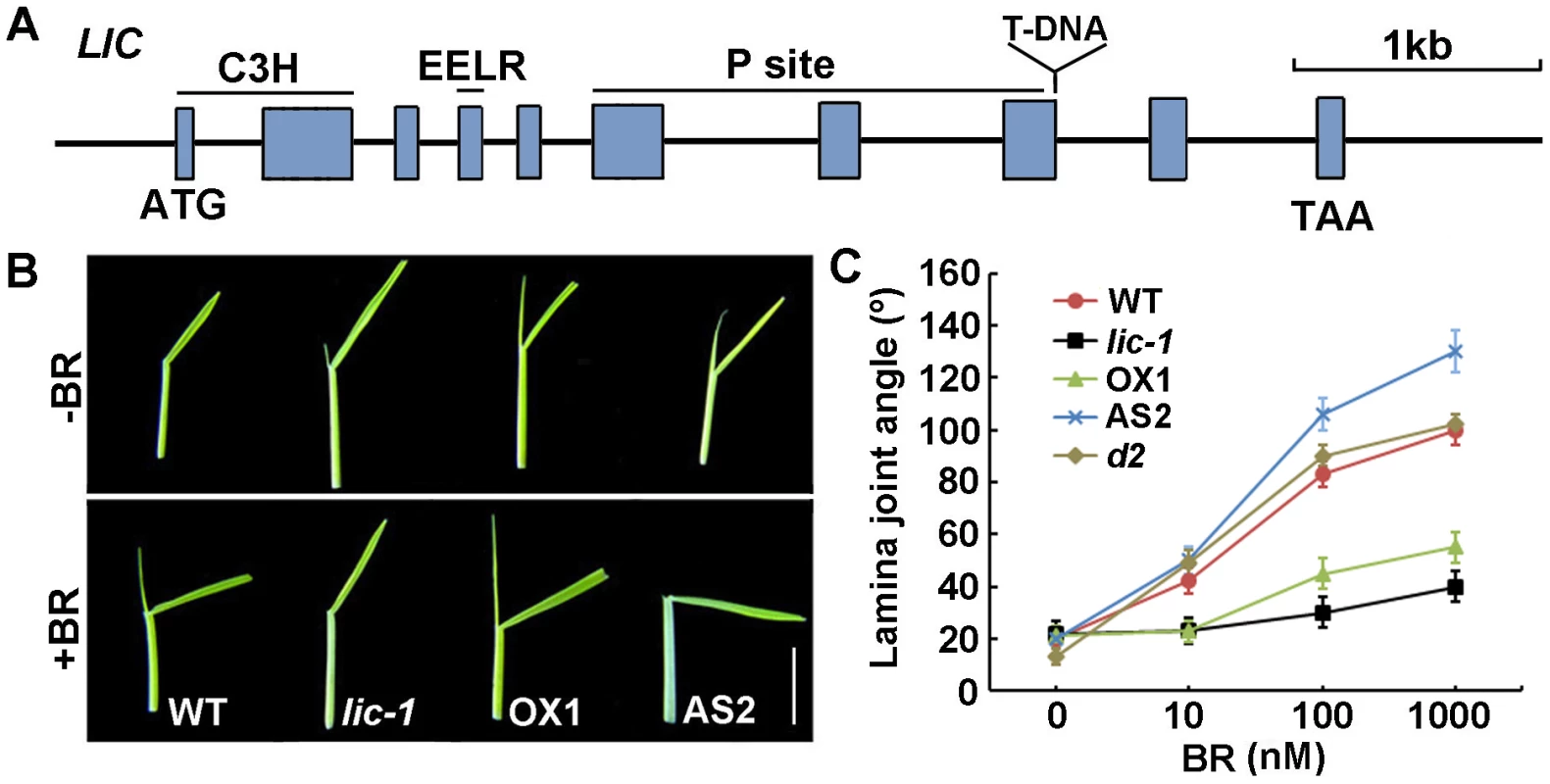
Segregation analysis of the heterozygous lic-1 with molecular evidence revealed an approximate 3∶1 (76/24) ratio of lic-1 mutants to the wild-type, which indicates that lic-1 is a dominant mutant. The crossed progenies of lic-1 and the LIC antisense lines showed increased leaf angles that were similar to those of the antisense lines (Table S1). As compared with wild type, the lic-1 line showed reduced leaf angles from tillering stage (Figure S2A and S2B). All LIC-overexpressing lines also showed erect leaves at tillering (Figure S2A, Figure S3, and Table S2). During the seedling stage, the wild type and lic-1, as well as overexpression lines, did not differ in leaf angle. Therefore, the phenotype of the lic-1 mutant was consistent with the LIC-overexpression lines in terms of leaf angle.
BR biosynthetic genes D2 and D11 had repressed expression in antisense lines. In contrast, the expression of the biosynthetic gene BRD1, as well as the receptor gene BRI1, was enhanced in lic-1 (Figure S4).
In rice, the physiologic processes of leaf bending and root growth are sensitive to BR [47], [48]. In the wild type (WT), increased leaf angle depended on the concentration of BR (Figure 1B and 1C). The overexpressing lines and lic-1 showed reduced dependence on BR concentration in leaf bending. In contrast, the antisense line was more sensitive to BR dosage than the WT. In the antisense lines, the root growth patterns in response to 24-eBL (an active form of BR) were similar to leaf angle patterns (Figure S5A and S5B). Thus, LIC overexpression reduced the BR response, and LIC depletion caused hypersensitivity to BR in terms of leaf bending and root growth. Therefore, LIC may negatively regulate BR signaling in rice.
OsLIC Is a Direct Target of OsBZR1
Bioinformatics analysis revealed the BZR1 binding site BRRE (CGTGT/CG) [26] present in the promoter of LIC (Figure 2A). EMSA was used to examine BZR1 binding to the cis-elements in the LIC promoter in vitro. When the purified BZR1 protein was incubated with the reaction mixture, a shifted band appeared in the upper part of the gel but not in the control MBP. The greater the amount of BZR1 in the incubation, the greater the amount of shifted band on the gel. When the competitive unlabeled probe (Co) was added to the system, the shifted band was suppressed. In contrast, neither mutated P1 (MP1, CGAAAA) nor P2 (CGTGTG) shifted under the same conditions (Figure 2B). We performed chromatin immunoprecipitation (ChIP) assay with WT rice (Figure S9). Real-time PCR revealed a fragment of the LIC promoter containing the P1 binding element significantly enriched as compared with the reference gene promoter (UBQ5) and control fragments (P2, P3 and P4; Figure 2C). In the RNAi lines of BZR1, LIC transcription was increased (Figure 2D). Thus, BZR1 binds to the cis-element in the LIC promoter, and knockdown of BZR1 leads to upregulation of LIC.
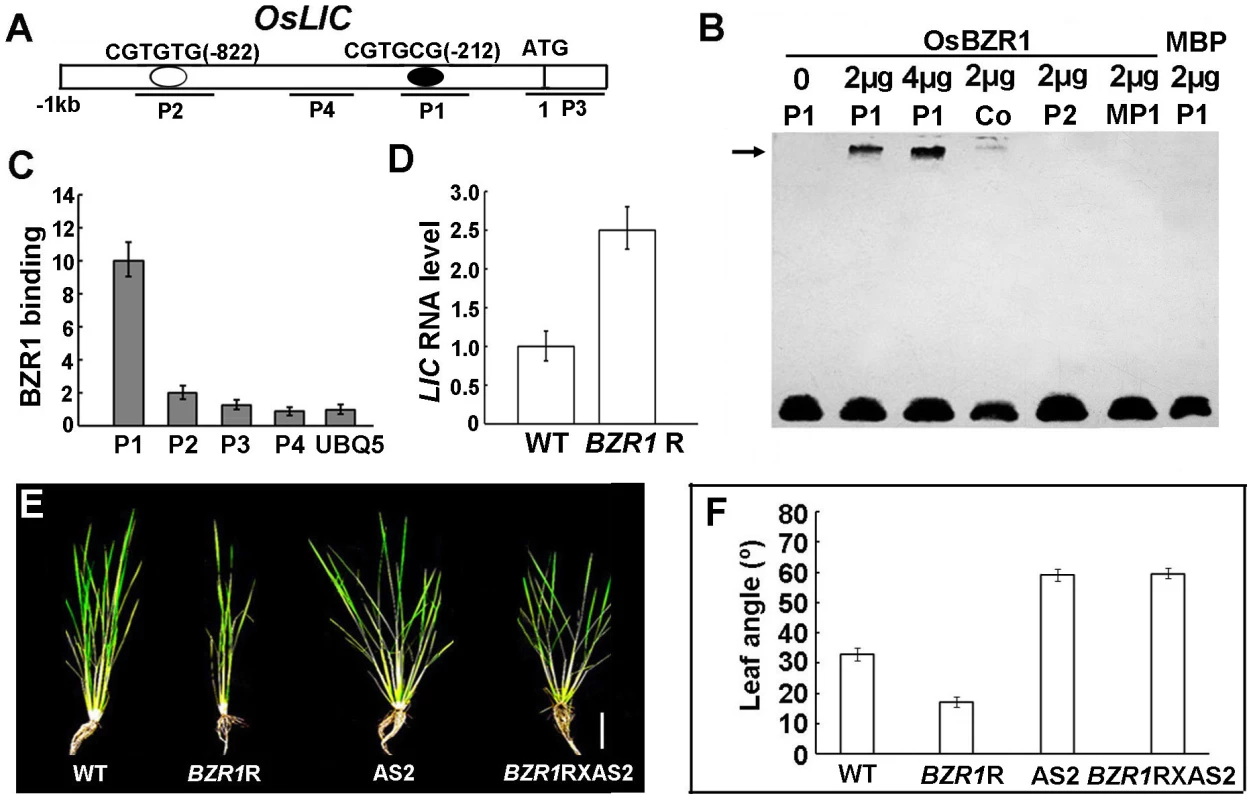
We crossed the BZR1 RNAi lines with erect leaves to the LIC antisense lines with increased leaf bending to explore the genetic relationship of the lines. By molecular identification (Figure S6A and S6B), phenotypic analysis revealed an increased leaf bending phenotype in the progenies, which was similar to that of the LIC antisense lines (Figure 2E and 2F). Therefore, BZR1 may functionally depend on LIC in terms of genetics.
LIC Is a Substrate of GSK3–Like Kinases, the Rice Orthologs of AtBIN2
Transformed LIC-GFP fusion protein was used to investigate subcellular localization. With BR treatment, GFP-tagged LIC was rapidly weakened in the cytoplasm within 30 min but was enhanced in the nucleus (Figure 3A a and b). The ratio of GFP-tagged LIC in the nucleus to that in the cytoplasm (N/C ratio) was significantly increased with BR treatment. Although LICm, mimicking the C-terminus-truncated protein, was distributed in the nucleus and cytoplasm, the cytoplasmic signal of LICm was clearly weaker than that of intact LIC (Figure 3A c and d; 3C). Digital signal assay demonstrated a lower ratio of LIC than truncated LICm in the nucleus. The LICm pattern showed a similar increased N/C ratio in response to BR treatment. In contrast, the truncated protein LICp, lacking the putative phosphorylation sites (designated P site in Figure 1A and Figure 3C) was localized only in the nucleus (Figure 3B). Western blot analysis revealed a greater LIC band in the nucleus of lic-1 as compared with the WT. Intensity of the nuclear band was enhanced by treatment with 24-eBL (1 µM) for both lic-1 and the WT. At the total protein level, the signal intensity of LIC in the WT and lic-1 was not significantly different after treatment (Figure 3D). Thus, the translocation of LIC from the cytoplasm to the nucleus may be regulated by BR treatment and depend on the phosphorylation status of LIC.
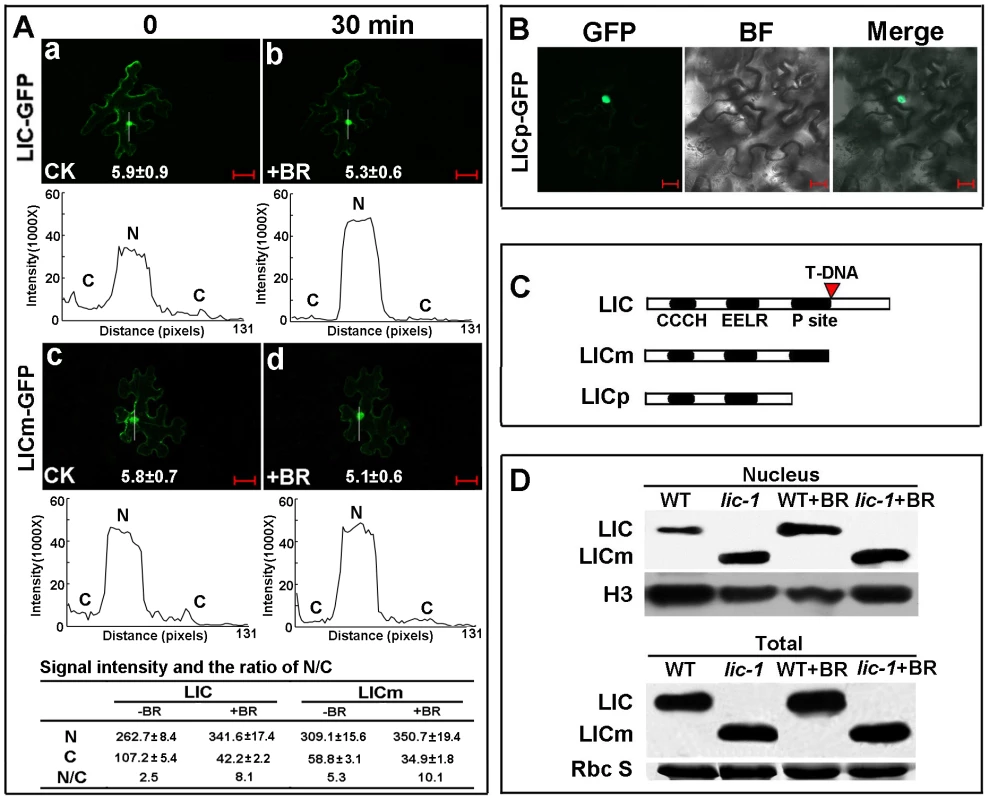
The GSK3-like kinase BIN2 phosphorylates BZR1 through the conserved GSK3 kinase phosphorylation sites (S/TxxxS/T) and promotes its cytoplasmic retention in Arabidopsis [49]. In rice, whole-genome screening analysis revealed two putative orthologs of BIN2, OsGSK1 and OsSKETHA [43].
Yeast two-hybrid assay revealed that LIC but not forms LICm and LICp interact with GSK1 and SKETHA, as well as AtBIN2. The mutated form did not interact with them (Figure S7). Western blot analysis revealed that LIC was two bands and the larger one was enhanced by incubation with BIN2. Furthermore, the intensity of the larger band was reduced by the addition of λ-phosphatase 1 (Figure 4A), which agreed with the prediction that 5 typical phosphorylation sites of GSK3-like kinases (S/TxxxS/T) were deposited in the P site domain of LIC protein.
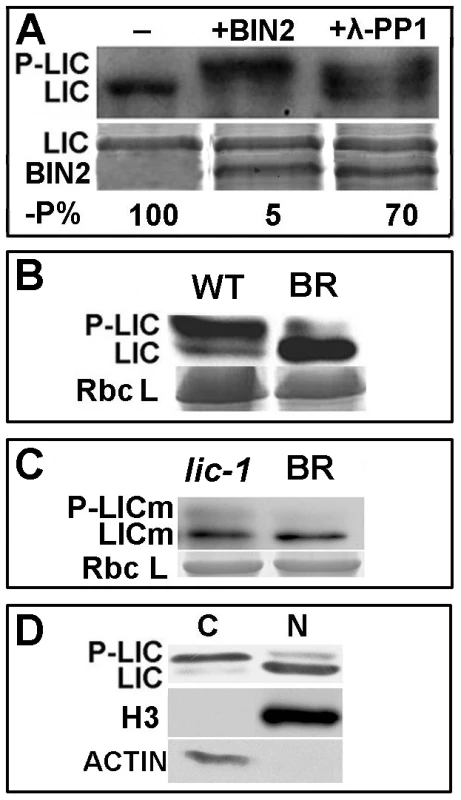
When plants were treated with 24-eBL (1 µM), the phosphorylated form of LIC was suppressed (Figure 4B), whereas the dephosphorylated form was increased. The P-LICm was weaker than that for LICm (Figure 4C). Western blot revealed dephosphorylated LIC accumulated in the nuclear fraction, with the phosphorylated form mainly in the cytoplasm (Figure 4D).
Transformed cells with GFP-tagged LIC showed the N/C ratio of LIC with digital fluorescence signals was 3.0 (Figure 5A and 5B). The nuclear distribution of LIC was enhanced with 24-eBL treatment. In contrast, in cells co-transformed with both GSK1 and LIC, less of LIC localized in the nucleus. Western blot analysis demonstrated that phosphorylated LIC was upregulated after incubation with GSK1 but downregulated with λ-phosphatase 1 (Figure 5C). This result suggested that GSK1 phosphorylated LIC, which might repress its localization in the nucleus.
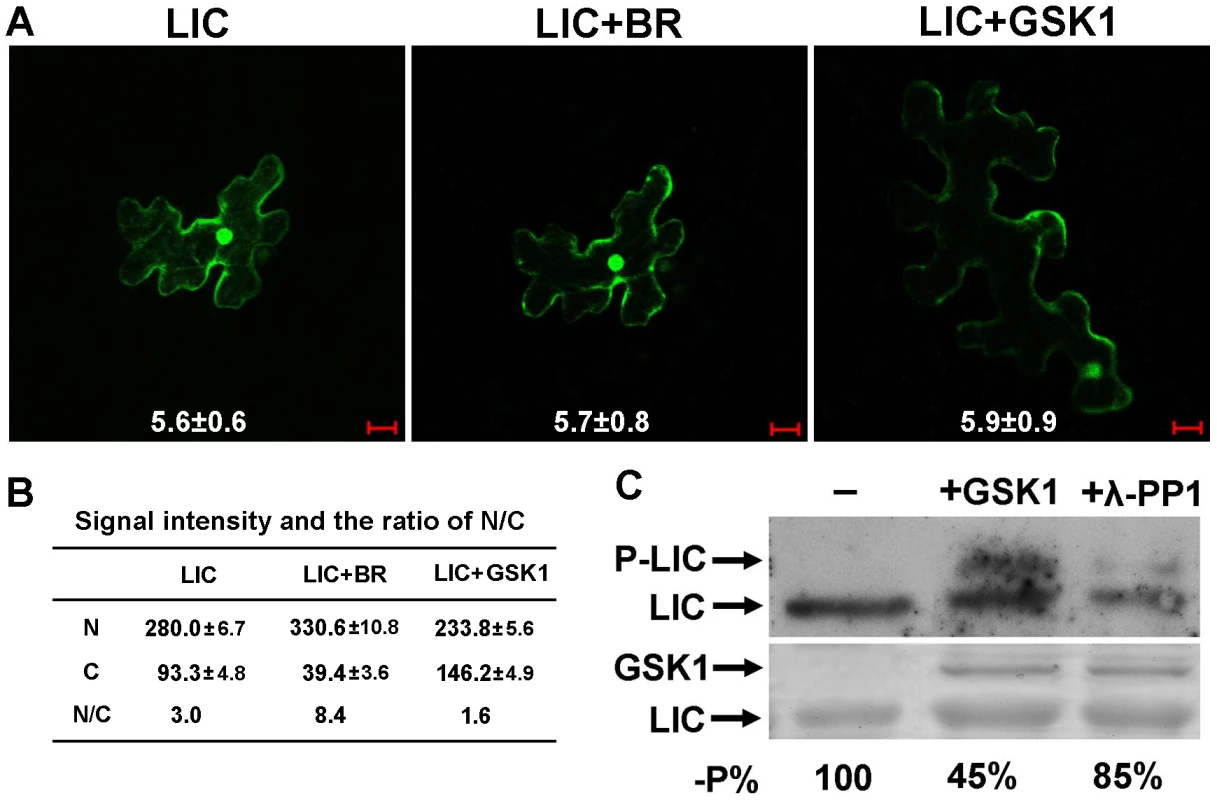
LIC Regulates BZR1 in a Negative Feedback Loop
Expression pattern assay demonstrated BZR1 and LIC with overlapping and distinct expression patterns in different organs (Figure S10). The expression of LIC was distributed from the abaxial to adaxial sides in leaves. In contrast, the expression of BZR1 was dominant in the abaxial sides of leaves (Figure 6A).
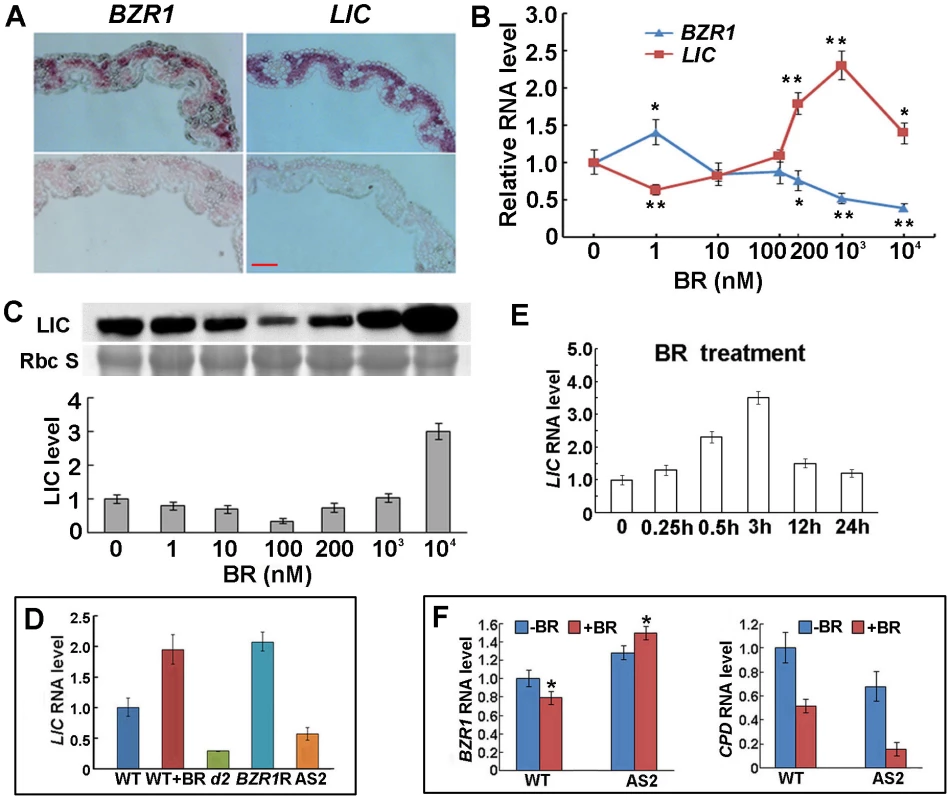
The effect of BR on LIC transcription showed repression at low (1 nM) and activation at high (>100 nM; Figure 6B) 24-eBL concentrations. This matches the phenotype of root growth (Figure S5C). The peak of LIC transcription occurred with 1 µM 24-eBL. In contrast, the mRNA level of BZR1 was increased with low levels of 24-eBL (1 nM) and decreased with high levels (>100 nM; Figure 6B). Western blot analysis demonstrated that the pattern of LIC protein level was similar to the mRNA pattern with low levels of 24-eBL. However, the reduced negative-peak occurred with a higher 24-eBL concentration (100 nM) than for the RNA (1 nM). Additionally, the increased protein expression was sustained with up to 10 µM 24-eBL (Figure 6C). Thus, LIC expression may be downregulated by a low level of BR but upregulated by higher concentrations.
In the mutant d2, BR deficiency caused LIC expression reduced to only 20% the WT level. BZR1 depletion resulted in increased LIC expression (Figure 6D). Time-course assay revealed LIC expression gradually increased from 15 min up to 3 h during BR treatment (1 µM 24-eBL) (Figure 6E). In the LIC antisense lines, BZR1 expression was enhanced with the treatment, which was opposite to that in the WT. Transcription expression of the BZR1 target gene CPD was greatly repressed by BR treatment in the antisense lines (Figure 6F). Thus, LIC may be involved in the negative regulation of BZR1.
To screen LIC potential target motifs, genes with altered expression of the LIC antisense lines in microarray data were re-sorted. In previous microarray analysis [10], the expression of 1,175 genes was altered by at least 2-fold in the LIC antisense lines. We extracted 1 kb of upstream sequences of the genes with altered expression patterns as the predicted promoters and then used MEME (http://meme.sdsc.edu/meme/cgi-bin/meme.cgi) to locate the recurrent motifs. We extracted 14 motifs representing the potential regulatory cis-elements from the altered genes (Figure S8A). EMSA results suggested that 3 elements (S1–3) containing a core sequence TCGC bound to LIC (Figure S8B). Therefore, the core sequence TCGC is one of the LIC-binding elements.
The core sequence was deposited in BZR1 gene. ChIP data revealed that LIC bound to the BZR1 promoter in various regions, such as, a, c, e, f, g and j, which were upregulated by BR treatment in the WT (Figure 7A and Figure S9). In contrast, the remaining fragments, which lacked TCGC, such as, b, d, h, I and k, had lower binding affinities. In the lic-1 mutant, the bound patterns were similar to that of the BR-treated WT.
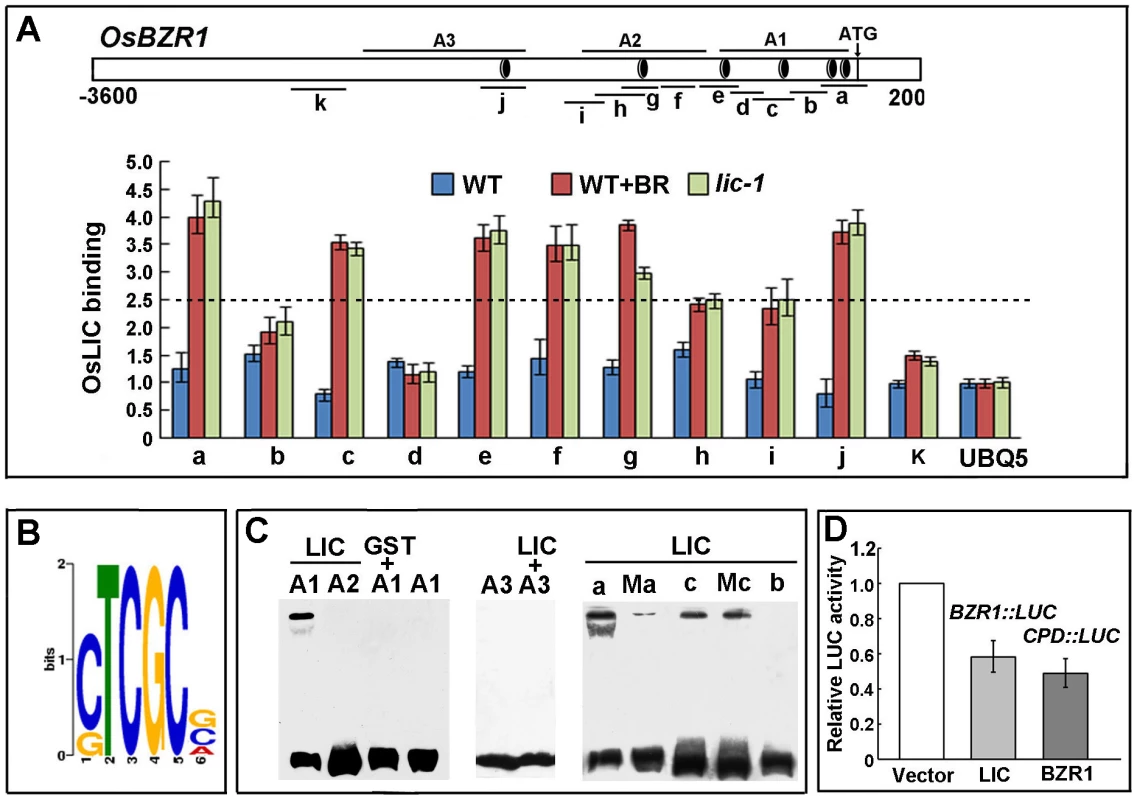
We used MEME to locate the recurrent motifs among the multiple region sequences identified on ChIP. The motif CTCGC (denoted as S, containing the TCGC core sequence) was consistently found with high values (Figure 7B and Figure S8C). EMSA demonstrated that LIC bound specifically to CTCGC (Figure S8D). Mutated probes M1 (ATCGCG) and M2 (CTCGCT) led to decreased intensity of the shifted band. In contrast, mutated M3 (CAAAAG) caused the band to disappear.
The fragments with multiple copies of the element on the BZR1 promoter were used to further confirm the binding activity. EMSA results suggested that binding affinities of LIC were related to copy numbers of the elements in the BZR1 promoter (Figure 7C). Transient transfection assay revealed that LIC protein repressed the expression of BZR1pro:LUC in Arabidopsis protoplasts as compared with the control (vector; Figure 7D) [26]. Therefore, LIC may be a primary transcription factor targeting OsBZR1 to regulate the BR signaling pathway.
LIC and BZR1 Function Antagonistically in Regulating Downstream Genes
To determine the potential antagonistic functions of both genes, we analyzed the expression patterns of their potential downstream genes. BZR1 mainly binds IBH1 to affect the balance of a pair of antagonistic HLH/bHLH transcription factors ILI1 and IBH1 in rice [45]. In an LIC-depleted line (AS2), ILI1 expression was higher than in the WT, whereas IBH1 transcription was not significantly altered (Figure 8A). The core motif sequence CTCGC of LIC target was present as a glomerate pattern in ILI1 but as a sparse pattern in IBH1. EMSA data indicated that the fragment containing the sequence B2 in ILI1 strongly bound to LIC. In contrast, the signal of C3 in IBH1 with a single core element was weaker (Figure 8B). ChIP analysis of the potential target ILI1 after BR treatment in the WT demonstrated significant changes (>2.5-fold) in binding in diverse regions such as a, d, e, f and n, but not in regions such as b, c, h, i, j and l (Figure 8C). IBH1 exhibited a similar pattern as ILI1 on ChIP analysis, but the copy number of the core element on the IBH1 fragments, such as c and k, was much lower than that for ILI1 (Figure 8D). Unexpectedly, the change appeared in the region without the core motif such as j, so other unknown motifs may be involved. To further explore the potential activity of the transcription factor with its targets ILI1 and IBH1, we used a protoplast transfection assay. LIC repressed the expression of ILI1pro:LUC but activated that of IBH1pro:LUC (Figure 8E). Competitive binding assay showed that the repression activity of LIC on ILI1 was weakened by co-expression of BZR1 (Figure 8F). Thus, LIC dominantly repressed ILI1 expression and weakly bound to IBH1 to enhance expression to balance the regulation activity of BZR1.
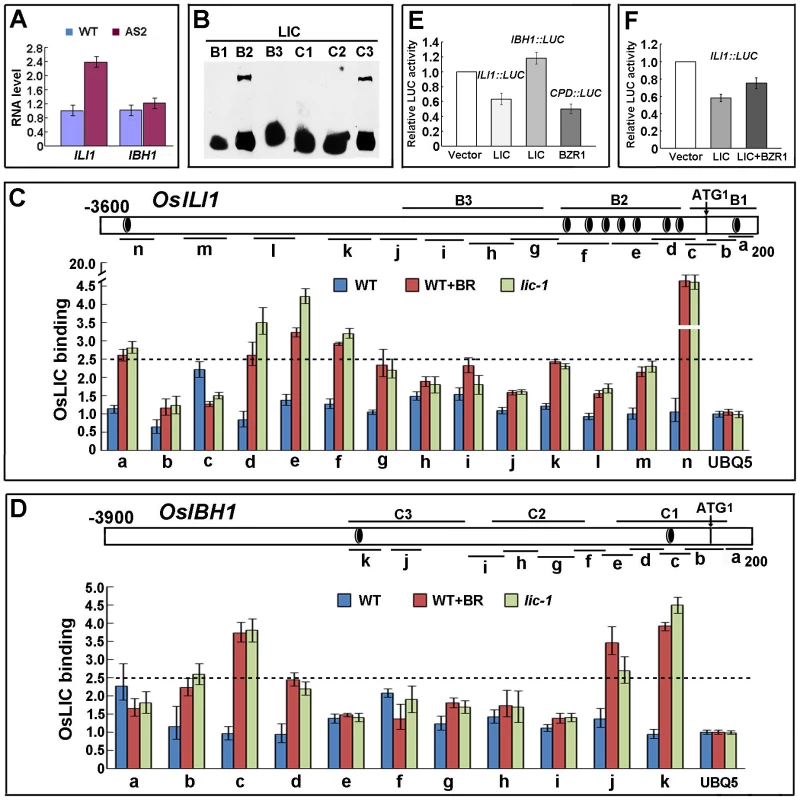
Discussion
BZR1 is one of the key nodes for components in the BR signaling pathway. Modification of phosphorylation on BZR1 modulates BR signaling to mediate growth and development in Arabidopsis [33], [34]. In this study, we identified LIC as a negative regulator of BZR1 to halt BR signaling to control leaf angle in rice. LIC antagonizes BZR1 by repressing its transcription in leaf bending (Figure 9). Like BZR1, the transcription factor LIC is phosphorylated by GSK1/BIN2. LIC and BZR1 are a pair of antagonistic transcription factors that repress each other during transcription. However, their repression strength may depend on BR level. The gain-of-function mutant lic-1 showed that LIC repressed BZR1 transcription and leaf bending, which may mimic a BR signaling balance to switch on the “brake.” The transcriptional expression of LIC and its protein accumulation in the nucleus were induced by BR. LIC dominantly binds to BZR1 and its target ILI1 and weakly to IBH1. In contrast, BZR1 mainly targets IBH1 to affect the balance of a pair of antagonistic HLH/bHLH transcription factors, except to bind LIC. The “seesaw” mechanism of the antagonistic function may work at various BR levels during plant development. BZR1 may function at a low level to promote signaling and LIC at higher levels for braking. Our data suggest that LIC is a component of the BR signaling pathway and mediates a novel braking module that represses BR signaling to control plant development.
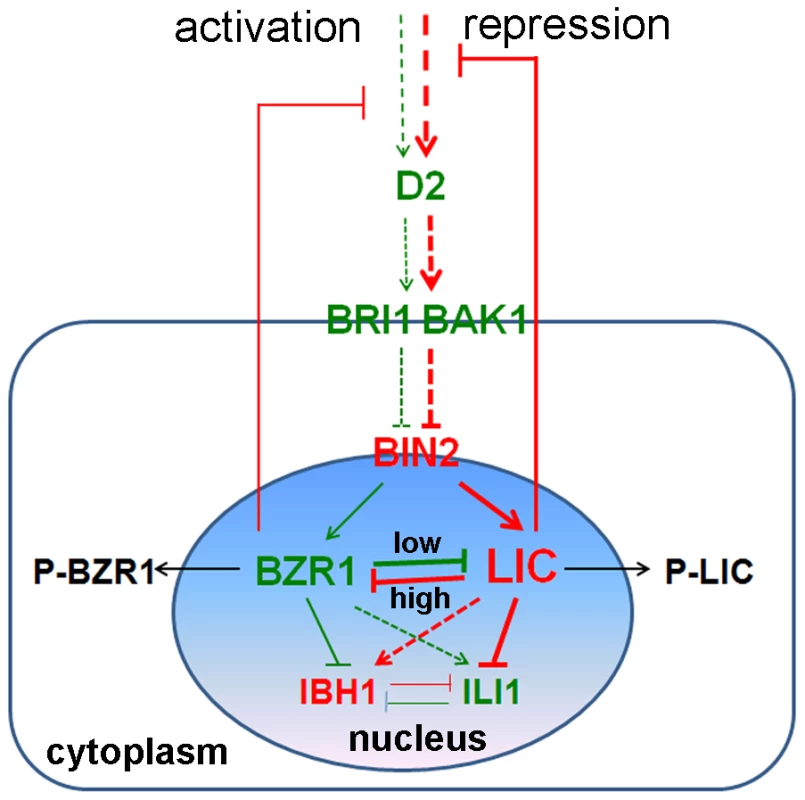
LIC Is a Major Negative Regulator Mediating Signaling from GSK3 Kinases
Leaf bending is a specific phenotypic response to BR in rice [47]. LIC-depleted rice lines show increased leaf bending, which mimic the phenotypes of enhanced responses to BR, such as the OsBAK1-overexpressing lines [40]. Consistently, the gain-of-function mutant lic-1 and overexpressing lines show erect leaves similar to OsBZR1- and OsBAK1-depleted lines. Reverse expression patterns of downstream genes such as ILI1 and IBHI1 were found in the silenced lines of BZR1 and LIC. Similarly like BZR1, LIC acts in an early BR response, because its expression was induced by BR treatment within 15 min. BR-induced LIC accumulation in the nucleus was a rapid response to BR and acts as an upstream component in BR signaling. Therefore, LIC functions negatively in the BR-mediated regulation of leaf bending.
LIC, with phosphorylation sites of GSK1/BIN2 kinases, interacts with BIN2 and its rice orthologs GSK1 and SKETHA and could be phosphorylated. The C-terminus-truncated LICm, as well as P-site-truncated LICp, show decreased interaction with GSK1/BIN2 and consequently display lower phosphorylation levels and greater accumulation in the nucleus to constitutively regulate downstream genes. The shuttle of LIC between the nucleus and cytoplasm was regulated by BR treatment and might depend on the phosphorylation status of LIC. This shuttle localization pattern depended on BIN2/GSK1, as seen with BZR1/BES1 [23], [42], [50]. Our results suggest that LIC directly mediates BR signaling from GSK3 kinases.
LIC Antagonizes BZR1 in Rice Leaf Bending
BZR1 is a key component positively regulating BR signaling, whereas LIC plays a negative role in the signaling pathway. With BR treatment, LIC and BZR1 accumulate in the nucleus and regulate downstream genes. BZR1 represses BR-downregulated genes through the downregulation of BIN2 phosphorylation and decreases cytoplasmic retention mediated by 14-3-3 proteins during BR-mediated induction [42], [50]. BZR1 and BES1 gain-of-function mutants in Arabidopsis are hypersensitive to BR. Depleted AtBES1 leads to reduced BR sensitivity [51]. The RNAi lines of OsBZR1 are insensitive to BR and show erect leaves [42]. Our genetic analysis and molecular data suggested that LIC and BZR1 work on rice leaf bending in a genetic pathway, but their roles are opposite to each other. EMSA and ChIP data, as well as transcription assay data, indicated that the BZR1 protein directly represses LIC expression via the specific BRRE motif (CGTGCG). We found that LIC protein recognizes the BZR1 gene through the core element (CTCGC) to repress its transcription. The expression of both genes may be induced by BR treatment at various concentrations. BR treatment at low concentrations (10−9 M) induced the expression of BZR1 and promoted the dephosphorylation of BZR1 protein as an activation mechanism. However, BR treatment at high concentrations (up to 10−7 M) induced LIC expression. The repression of BZR1 transcriptional expression by LIC is enhanced by high BR levels. Therefore, LIC and BZR1 antagonize each other in controlling BR-mediated leaf bending.
LIC, with only one CCCH domain, binds DNA or RNA in vitro (Figure S11) [10]. It prefers to recognize the core sequence CTCGC, which is present in genes such as BZR1 and ILI1, to regulate BR signaling in rice. Our finding of the motif binding to LIC with specificity will provide new insights into this family.
BZR1 is a transcription factor that represses the expression of downstream genes such as OsIBH1, which is responsible for leaf bending. ILI1/PRE1 and IBH1 promote or repress cell elongation downstream of BZR1 in rice and Arabidopsis [45], [52]. Overexpression of ILI1 causes increased leaf bending, whereas overexpression of IBH1 results in erect leaves in rice. EMSA and ChIP results suggested that LIC greatly represses ILI1, the positive partner of OsIBH1. As well, LIC weakly binds to OsIBH1 promoter to enhance its transcriptional expression. This pattern is similar to BZR1 weakly binding to the promoter of ILI1, which is induced by BR [45]. In regulating downstream genes, LIC may play a major role in repressing positive regulators such as ILI1, and BZR1 may function to repress negative regulators such as IBH1. Therefore, a novel negative regulation module of BR signaling is parallel to and antagonizes the BZR1 signaling pathway to regulate leaf bending. In plant development, LIC and BZR1 show various spatial and temporal expression patterns. BZR1 acts in the presence of low levels of BR, whereas LIC is predominantly activated by high levels of BR and antagonizes BZR1 to prevent intense activation of the BR cascade. The novel negative regulation module of LIC and the positive one of BZR1 in mediating leaf bending may help in designing ideal plant architecture for improving photosynthesis efficiency during rice development. The approach may have potential in rice molecular breeding for high yield.
Materials and Methods
Plant Materials and Growth Conditions
Rice (Oryza sativa ssp. japonica var. Zhonghua 10) plants were grown in the field or in the greenhouse at 30°C/25°C (day/night) cycles. For the analysis of BR induction in leaf bending and root growth, rice seeds were sterilized with 1% NaClO and grown in half-strength Murashige and Skoog (MS) medium with the indicated concentrations of 24-eBL (Sigma-Aldrich, St. Louis, MO, USA) at 30°C under continuous light. Seedlings were examined 7 days after germination. For every transgenic rice plant, 3 lines were used.
Leaf-Bending Assay
Sterilized seeds were grown for 8 days in a dark chamber. Uniform seedlings were then sampled by excising segments of approximately 2 cm that contained the second-leaf lamina joint under dim light conditions. These were floated on distilled water containing various concentrations of 24-eBL. After incubation in a dark chamber at 30°C for 72 h, the angle between the lamina and the sheath was measured [47].
Total RNA Isolation and Quantitative RT–PCR Analysis
Total RNA was extracted from 2-week-old seedlings by using the Trizol RNA extraction kit (Invitrogen, Carlsbad, CA, USA). The first-strand cDNAs were synthesized by use of M_MLV reverse transcriptase (Promega) and used as RT-PCR templates. Quantitative real-time PCR analysis involved an Mx3000P (Stratagene) with a SYBR green detection protocol. RT-PCR was repeated at least 3 times for each harvested samples with gene-specific primers and ACTIN1 as the reference gene (see Table S1). The data were analyzed by the CT formula considering amplification efficiencies for every PCR [53].
Vector Construction and Plant Transformation
The cDNA of LIC from a rice cDNA library was amplified by PCR and ligated into pUN1301 binary vectors for overexpression. Full-length cDNAs of LIC, GSK1, SKETHA, and AtBIN2 without the stop codon were amplified by PCR from rice or Arabidopsis and cloned into pGADT7 or pGBDT7 vectors. All binary vector constructs were transformed into Agrobacterium tumefaciens strain GV3101 or EHA105, then transformed into rice calli by A. tumefaciens-mediated transfection [54], [55]. Primers are in Table S4.
For tobacco transformation, full-length cDNAs of LIC and GSK1 were ligated into pBI121 and pRT105-3×flag vectors [56], respectively. The binary vector constructs were transformed into A. tumefaciens strain GV3101 and then transformed into tobacco by A. tumefaciens-mediated transfection.
Protoplast Transient Expression Assay
Full-length LIC sequence was inserted into the pBI221 vector to generate pBI221-LIC. To generate the BZR1pro:LUC reporter gene, the BZR1 promoter was amplified with the rice genomic DNA used as a template and then inserted into the pGEM-T Easy vector to produce pGEM-BZR1p. The BZR1 promoter was released from pGEM-BZR1p by digestion with HindIII and BamHI and inserted into the corresponding sites of the YY96 vector [57] to produce BZR1pro:LUC. The ILI1pro:LUC and IBH1pro:LUC reporter genes were constructed as for BZR1pro:LUC.
Isolation of Arabidopsis protoplasts and PEG-mediated transfection were as described [58]. The reporter constructs BZR1pro:LUC, ILI1pro:LUC and IBH1pro:LUC; effector plasmid; and 35S:GUS construct (internal control) were co-transformed into protoplasts. After transformation, the protoplasts were incubated at 23°C for 12–15 h, then pelleted and resuspended in 100 µL of 1× CCLR buffer (Promega). For the ß-glucuronidase enzymatic assay, 5 µL extract was incubated with 50 µL 4-methylumbelliferyl ß-d-glucuronide assay buffer (50 mM sodium phosphate, pH 7.0, 1 mM ß-d-glucuronide, 10 mM EDTA, 10 mM ß-mercaptoethanol, 0.1% sarkosyl, 0.1% Triton X-100) at 37°C for 15 min, and the reaction was stopped by adding 945 µL of 0.2 M Na2CO3. For luciferase activity assay, 5 µL extract was mixed with 50 µL luciferase assay substrate (Promega), and activity was detected with use of a Modulus Luminometer/Fluometer with a luminescence kit (Promega). The reporter gene expression was expressed as relative ratio of LUC to ß-glucuronidase.
Yeast Two-Hybrid Screening
The cDNA of LIC was cloned into the pGADT7 vector. The cDNAs of GSK1, SKETHA, and AtBIN2 were cloned into pGBDT7 (Stratagene) and then transformed into yeast strain AH109. Transformants were screened for growth on medium lacking Leu, Trp, and His. Recovered clones were then assayed for LacZ activity by a filter lift assay. For the transactivation activity assay, LIC, AtBIN2, GSK1, and SKETHA were cloned into the pGBDT7 vector and co-transformed with pGADT7 into yeast cells. Yeast that could grow on SD/-Leu/-Trp/-His medium with ß-galactosidase activity exhibited transactivation activity.
Western blot analysis involved extracts prepared from yeast cells as described [14]. The yeast cells were collected, ground to a fine powder in liquid nitrogen, and further ground in cold grinding buffer (50 mM HEPES (pH 7.4), 10 mM EDTA, 0.1% Triton X-100, 1 mM PMSF). After the addition of an equal volume of 2× sample buffer, the samples were boiled for 10 min, separated by 15% SDS–PAGE, and transferred to a polyvinylidene fluoride membrane. The blots were incubated with the antibodies mouse anti-Myc (Neo-Marker, UK) or mouse anti-HA (Santa Cruz, Germany), then goat anti-mouse IgG HRP-conjugated secondary antibody (Santa Cruz, Germany).
ChIP and EMSA
Chromatin immunprecitipation (ChIP) was performed as described [26] with 3-week-old seedlings. The antibody polyclonal anti-BZR1 or anti-LIC was used for immunoprecipitation. Untagged purified LIC protein was used to inject rabbit, and polyclonal serum was affinity-purified with its target antigen. ChIP products were analyzed by quantitative real-time PCR, and enrichment was calculated as the ratio of transgenic to wild-type sample or BR-treated and control seedlings. Data are mean±SD from 3 biological replicates. The primers for UBQ5 (LOC_Os04g57220) promoter were 5′-TATCCAACATGAATGCCACA-3′ and 5′-CAGCACGAGATGAGTAAAACAA-3′. Sequences used in bioinformatics analysis are in Table S3.
EMSA was performed essentially as described [59]. Briefly, the OsBZR1 coding region was cloned into a maltose-binding protein (MBP) fusion vector (pETMALc-H vector, Pryor and Leiting, 1997) with the primers for OsBES1NAsp718, 5′-CTCGGTACCGGAGCTGGTGGGTATGACGTC-3′, and OsBES1CHind3, 5′-CGCAAGCTTTCATTTCGCGCCGACGCCGAGC-3′. The recombinant MBP–OsBZR1 was purified from Escherichia coli with amylose resin (NEB, http://www.neb.com) according to the manufacturer's instructions [60]. The coding sequence of LIC was cloned into the expression vector pGEX-4T-1 [10]. The construct was transformed into E. coli BL21 (DE3). Cells were grown at 30°C and induced by the addition of isopropyl β-d-thiogalactopyranoside at a final concentration of 1 mM when the optical density (OD)600 of the cultured cells was 0.5–0.9. The fusion protein was purified with Glutathione Sepharose 4B (GE Healthcare). The nucleotide sequences of the double-stranded oligonucleotides for EMSA were for LIC P1 (5′-CGA CGT CGT GCG GCC GCG-3′ and 5′-CGC GGC CGC ACG ACG TCG-3′) and LIC P2 (5′-CGG GCG CGT GTG TGG CGG-3′ and 5′-CCG CCA CAC ACG CGC CCG-3′). The oligonucleotides were annealed and then labeled with the Biotin 3′ End DNA Labeling Kit (Pierce). Standard reaction mixtures (20 µL) for EMSA contained 2 µg purified proteins, 2 µL biotin-labeled annealed oligonucleotides, 2 µL 10×binding buffer (100 mM Tris, 500 mM KCl, 10 mM DTT, pH 7.5), 1 µL 50% glycerol, 1 µL 1% NP-40, 1 µL 1 M KCl, 1 µL 100 mM MgCl2, 1 µL 200 mM EDTA, 1 µL 1 µg/µL poly (dI-dC) and 8 µL ultrapure water. The reactions were incubated at room temperature (25°C) for 20 min and loaded onto a 10% native polyacrylamide gel containing 45 mM Tris, 45 mM boric acid, 1 mM EDTA, pH 8.3. The gel was sandwiched and transferred to an N+ nylon membrane (Millipore) in 0.5× TBE buffer at 380 mA in a 4°C refrigerator for 60 min. The detection of biotin-labeled DNA by chemiluminescence followed the manual of the LightShift Chemiluminescent EMSA Kit (PIERCE).
Confocal Microscopy and Quantification of Protein Fluorescent Signal
GFP fluorescence was visualized under a confocal microscope (Zeiss LSM510 META, Germany) equipped with an argon laser (488 nm). GFP was excited by an Argon laser at 488 nm, and images were acquired using a 512b Roper Cascade EMCCD camera and MetaMorph software (Molecular Devices, Sunnyvale, CA). Images of LIC-, LICm-, and LICp-GFP were obtained with identical image acquisition settings. A series of images at different points along the z-axis were collected from the top to the bottom. Projection of the z-series of images results in a 3D view of the cell. To quantify the effect of 24-eBL on OsLIC-GFP localization in the time-course experiment, images were obtained with a 500-ms exposure time. Quantification of the fluorescent protein signal involved use of ImageJ (http://rsb.info.nih.gov/ij). To measure the ratio of nuclear to cytoplasmic signals (N/C ratio) for LIC-GFP for each cell, small areas were drawn, and measurements of integrated densities were taken from representative areas within the nucleus, cytoplasm, and background (central vacuole) of each cell. Each sample of at least 20 cells was measured 3 times; the average N/C ratio were then calculated [42].
Western Blot Analysis and Kinase Assay In Vitro
Total protein samples were extracted from 2-week-old rice seedlings with 2× SDS loading buffer; cytoplasmic and nuclear fractions were extracted as described [20], [61]. Tissues were lysed with use of a buffer (20 mM Tris-HCl, pH 7.0, 250 mM sucrose, 25% glycerol, 20 mM KCl, 2 mM EDTA, 2.5 mM MgCl2, 30 mM ß-mercaptoethanol, 13-protease inhibitor cocktail, and 0.7% Triton X-100) and fractionated by centrifugation at 3000×g. The supernatant was taken as the cytosolic fraction. The pellet was further washed with a resuspension buffer (20 mM Tris-HCl, pH 7.0, 25% glycerol, 2.5 mM MgCl2, and 30 mM ß-mercaptoethanol) and reconstituted as the nuclear fraction. All proteins were separated on SDS-PAGE gels, transferred to a nitrocellulose membrane, and probed with anti-LIC antibody. For the in vitro kinase assay, purified LIC-GST protein was incubated with BIN2/GSK1 protein or λ-phosphorylase 1 at 30°C for 30 min and loaded onto SDS-PAGE gels. SDS-PAGE gels of 8% or 15% were used to analyze the total LIC level or its phosphorylation, respectively. The proteins were transferred to a nitrocellulose membrane until the 35-kDa protein marker ran out of the gel during electrophoresis.
RNA Hybridization In Situ
Tissues were fixed in 4% (w/v) paraformaldehyde and 0.25% glutaraldehyde in 0.1 M sodium phosphate buffer; samples were vacuum-infiltrated for 30 min and then stored overnight at 4°C. The dehydrated samples after a graded ethanol series were embedded in Paraplast Plus (Oxford Labware, St. Louis, MO). A fragment of 232 bp was amplified from the second exon of LIC with the primers 5′-GGATCCGCAAGTACGGAGCGCAGTG-3′ and 5′-AAGCTTTTCG CAGGACCAGGAGCA-3′, subcloned into the pGEM-T-easy vector (Promega), and used as a template for RNA probe synthesis. A fragment of BZR1 was amplified with the primers 5′-ATCAGGAAGCCGGACTGGG-3′ and 5′-GGTTGACGAGGTTGTAGGTGGG-3′. Hybridization in situ with digoxigenin-labeled sense or antisense RNA of LIC and BZR1 was conducted as described [62].
Bioinformatics Analysis of the Putative Binding Motif
MEME software (http://meme.sdsc.edu/meme/cgi-bin/meme.cgi) was used to find recurrent motifs among multiple sequences in Affymetrix microarray data for the LIC antisense lines that were up- or downregulated by at least 2-fold [10]. We extracted 1-kb genomic sequences upstream of 1,175 genes to screen the potential motifs. Differentially expressed genes were divided into those up- or downregulated. Randomly generated sequences of the same length were used as controls to remove false-positive results.
Accession Numbers
Sequence data from this article can be found in the GenBank or EMBL database under the following accession numbers: LIC, Os06g49080; GSK1, Os01g10840; SKETHA, Os06g35530; ILI1, Os04g54900; Os IBH1, Os04g0660100.
Supporting Information
Zdroje
1. SakamotoT 2006 Phytohormones and rice crop yield: strategies and opportunities for genetic improvement. Transgenic Res 15 399 404
2. SakamotoTMorinakaYOhnishiTSunoharaHFujiokaS 2006 Erect leaves caused by brassinosteroid deficiency increase biomass production and grain yield in rice. Nat Biotechnol 24 105 109
3. ClouseSDSasseJM 1998 BRASSINOSTEROIDS: Essential Regulators of Plant Growth and Development. Annu Rev Plant Physiol Plant Mol Biol 49 427 451
4. BishopGJKonczC 2002 Brassinosteroids and plant steroid hormone signaling. Plant Cell 14 Suppl S97 110
5. FukudaH 2004 Signals that control plant vascular cell differentiation. Nat Rev Mol Cell Biol 5 379 391
6. ChoryJNagpalPPetoCA 1991 Phenotypic and Genetic Analysis of det2, a New Mutant That Affects Light-Regulated Seedling Development in Arabidopsis. Plant Cell 3 445 459
7. SzekeresMNemethKKoncz-KalmanZMathurJKauschmannA 1996 Brassinosteroids rescue the deficiency of CYP90, a cytochrome P450, controlling cell elongation and de-etiolation in Arabidopsis. Cell 85 171 182
8. LiJChoryJ 1997 A putative leucine-rich repeat receptor kinase involved in brassinosteroid signal transduction. Cell 90 929 938
9. MoriMNomuraTOokaHIshizakaMYokotaT 2002 Isolation and characterization of a rice dwarf mutant with a defect in brassinosteroid biosynthesis. Plant Physiol 130 1152 1161
10. WangLXuYZhangCMaQJooSH 2008 OsLIC, a Novel CCCH-Type Zinc Finger Protein with Transcription Activation, Mediates Rice Architecture via Brassinosteroids Signaling. PLoS ONE 3 e3521 doi:10.1371/journal.pone.0003521
11. KimTWWangZY 2010 Brassinosteroid signal transduction from receptor kinases to transcription factors. Annu Rev Plant Biol 61 681 704
12. TangWDengZWangZY 2009 Proteomics shed light on the brassinosteroid signaling mechanisms. Curr Opin Plant Biol 13 27 33
13. WangZYSetoHFujiokaSYoshidaSChoryJ 2001 BRI1 is a critical component of a plasma-membrane receptor for plant steroids. Nature 410 380 383
14. NamKHLiJ 2002 BRI1/BAK1, a receptor kinase pair mediating brassinosteroid signaling. Cell 110 203 212
15. LiJWenJLeaseKADokeJTTaxFE 2002 BAK1, an Arabidopsis LRR receptor-like protein kinase, interacts with BRI1 and modulates brassinosteroid signaling. Cell 110 213 222
16. WangXChoryJ 2006 Brassinosteroids regulate dissociation of BKI1, a negative regulator of BRI1 signaling, from the plasma membrane. Science 313 1118 1122
17. GouXPYinHJHeKDuJBYiJ 2011 Genetic Evidence for an Indispensable Role of Somatic Embryogenesis Receptor Kinases in Brassinosteroid Signaling. PLoS Genet 8 e1002452 doi:10.1371/journal.pgen.1002452
18. TangWKimTWOses-PrietoJASunYDengZ 2008 BSKs mediate signal transduction from the receptor kinase BRI1 in Arabidopsis. Science 321 557 560
19. WangZYNakanoTGendronJHeJChenM 2002 Nuclear-localized BZR1 mediates brassinosteroid-induced growth and feedback suppression of brassinosteroid biosynthesis. Dev Cell 2 505 513
20. RyuHKimKChoHParkJChoeS 2007 Nucleocytoplasmic shuttling of BZR1 mediated by phosphorylation is essential in Arabidopsis brassinosteroid signaling. Plant Cell 19 2749 2762
21. HeJXGendronJMYangYLiJWangZY 2002 The GSK3-like kinase BIN2 phosphorylates and destabilizes BZR1, a positive regulator of the brassinosteroid signaling pathway in Arabidopsis. Proc Natl Acad Sci U S A 99 10185 10190
22. LiJNamKHVafeadosDChoryJ 2001 BIN2, a new brassinosteroid-insensitive locus in Arabidopsis. Plant Physiol 127 14 22
23. RyuHKimKChoHHwangI 2010 Predominant actions of cytosolic BSU1 and nuclear BIN2 regulate subcellular localization of BES1 in brassinosteroid signaling. Mol Cells 29 291 296
24. YanZZhaoJPengPChiharaRKLiJ 2009 BIN2 functions redundantly with other Arabidopsis GSK3-like kinases to regulate brassinosteroid signaling. Plant Physiol 150 710 721
25. ZhaoJPengPSchmitzRJDeckerADTaxFE 2002 Two putative BIN2 substrates are nuclear components of brassinosteroid signaling. Plant Physiol 130 1221 1229
26. HeJXGendronJMSunYGampalaSSGendronN 2005 BZR1 is a transcriptional repressor with dual roles in brassinosteroid homeostasis and growth responses. Science 307 1634 1638
27. YinYWangZYMora-GarciaSLiJYoshidaS 2002 BES1 accumulates in the nucleus in response to brassinosteroids to regulate gene expression and promote stem elongation. Cell 109 181 191
28. GuoHYeHLiLYinY 2009 A family of receptor-like kinases are regulated by BES1 and involved in plant growth in Arabidopsis thaliana. Plant Signal Behav 4 784 786
29. LiLYuXThompsonAGuoMYoshidaS 2009 Arabidopsis MYB30 is a direct target of BES1 and cooperates with BES1 to regulate brassinosteroid-induced gene expression. Plant J 58 275 286
30. LiLYeHGuoHYinY 2010 Arabidopsis IWS1 interacts with transcription factor BES1 and is involved in plant steroid hormone brassinosteroid regulated gene expression. Proc Natl Acad Sci U S A 107 3918 3923
31. SunYFanXYCaoDMTangWHeK 2010 Integration of brassinosteroid signal transduction with the transcription network for plant growth regulation in Arabidopsis. Dev Cell 19 765 777
32. YuXLiLZolaJAluruMYeH 2011 A brassinosteroid transcriptional network revealed by genome-wide identification of BESI target genes in Arabidopsis thaliana. Plant J 65 634 646
33. Di RubboSIraniNGRussinovaE 2011 PP2A Phosphatases: The “On-Off” Regulatory Switches of Brassinosteroid Signaling. Sci Signal 4 pe25
34. WuGWangXLiXKamiyaYOteguiMS 2011 Methylation of a phosphatase specifies dephosphorylation and degradation of activated brassinosteroid receptors. Sci Signal 4 ra29
35. TangWYuanMWangRYangYWangC 2011 PP2A activates brassinosteroid-responsive gene expression and plant growth by dephosphorylating BZR1. Nat Cell Biol 13 124 131
36. HongZUeguchi-TanakaMUmemuraKUozuSFujiokaS 2003 A rice brassinosteroid-deficient mutant, ebisu dwarf (d2), is caused by a loss of function of a new member of cytochrome P450. Plant Cell 15 2900 2910
37. TanabeSAshikariMFujiokaSTakatsutoSYoshidaS 2005 A novel cytochrome P450 is implicated in brassinosteroid biosynthesis via the characterization of a rice dwarf mutant, dwarf11, with reduced seed length. Plant Cell 17 776 790
38. HongZUeguchi-TanakaMFujiokaSTakatsutoSYoshidaS 2005 The Rice brassinosteroid-deficient dwarf2 mutant, defective in the rice homolog of Arabidopsis DIMINUTO/DWARF1, is rescued by the endogenously accumulated alternative bioactive brassinosteroid, dolichosterone. Plant Cell 17 2243 2254
39. WangLXuYYMaQBLiDXuZH 2006 Heterotrimeric G protein alpha subunit is involved in rice brassinosteroid response. Cell Res 16 916 922
40. LiDWangLWangMXuYYLuoW 2009 Engineering OsBAK1 gene as a molecular tool to improve rice architecture for high yield. Plant Biotechnol J 7 791 806
41. UllahHChenJGYoungJCImKHSussmanMR 2001 Modulation of cell proliferation by heterotrimeric G protein in Arabidopsis. Science 292 2066 2069
42. BaiMYZhangLYGampalaSSZhuSWSongWY 2007 Functions of OsBZR1 and 14-3-3 proteins in brassinosteroid signaling in rice. Proc Natl Acad Sci U S A 104 13839 13844
43. KohSLeeSCKimMKKohJHLeeS 2007 T-DNA tagged knockout mutation of rice OsGSK1, an orthologue of Arabidopsis BIN2, with enhanced tolerance to various abiotic stresses. Plant Mol Biol 65 453 466
44. YamamuroCIharaYWuXNoguchiTFujiokaS 2000 Loss of function of a rice brassinosteroid insensitive1 homolog prevents internode elongation and bending of the lamina joint. Plant Cell 12 1591 1606
45. ZhangLYBaiMYWuJZhuJYWangH 2009 Antagonistic HLH/bHLH transcription factors mediate brassinosteroid regulation of cell elongation and plant development in rice and Arabidopsis. Plant Cell 21 3767 3780
46. ZhangJLiCWuCXiongLChenG 2006 RMD: a rice mutant database for functional analysis of the rice genome. Nucleic Acids Res 34 D745 748
47. WadaKMarumoSIkekawaNMorisakiMMoriK 1981 Brassinolide and homobrassinolide promotion of lamina inclination of rice seedlings. Plant Cell Physiol 22 323 325
48. MaedaE 1965 Rate of lamina inclination in excised rice leaves. Physiol Plant 18 813 827
49. LiJNamKH 2002 Regulation of brassinosteroid signaling by a GSK3/SHAGGY-like kinase. Science 295 1299 1301
50. GampalaSSKimTWHeJXTangWDengZ 2007 An essential role for 14-3-3 proteins in brassinosteroid signal transduction in Arabidopsis. Dev Cell 13 177 189
51. YinYVafeadosDTaoYYoshidaSAsamiT 2005 A new class of transcription factors mediates brassinosteroid-regulated gene expression in Arabidopsis. Cell 120 249 259
52. WangHZhuYFujiokaSAsamiTLiJ 2009 Regulation of Arabidopsis brassinosteroid signaling by atypical basic helix-loop-helix proteins. Plant Cell 21 3781 3791
53. SchefeJHLehmannKEBuschmannIRUngerTFunke-KaiserH 2006 Quantitative real-time RT-PCR data analysis: current concepts and the novel “gene expression's CT difference” formula. J Mol Med (Berl) 84 901 910
54. WangZChenCXuYJiangRHanYXuZChongK 2004 A practical vector for efficient knockdown of gene expression in rice (Oryza sativa L.). Plant Mol Biol Rep 22 409 417
55. CloughSJBentAF 1998 Floral dip: a simplified method for Agrobacterium-mediated transformation of Arabidopsis thaliana. Plant J 16 735 743
56. ZhaoJZhangWZhaoYGongXGuoL 2007 SAD2, an importin -like protein, is required for UV-B response in Arabidopsis by mediating MYB4 nuclear trafficking. Plant Cell 19 3805 3818
57. YamamotoYYMatsuiMAngLHDengXW 1998 Role of a COP1 interactive protein in mediating light-regulated gene expression in arabidopsis. Plant Cell 10 1083 1094
58. KovtunYChiuWLTenaGSheenJ 2000 Functional analysis of oxidative stress-activated mitogen-activated protein kinase cascade in plants. Proc Natl Acad Sci U S A 97 2940 2945
59. MaQDaiXXuYGuoJLiuY 2009 Enhanced tolerance to chilling stress in OsMYB3R-2 transgenic rice is mediated by alteration in cell cycle and ectopic expression of stress genes. Plant Physiol 150 244 256
60. TongHJinYLiuWLiFFangJ 2009 DWARF AND LOW-TILLERING, a new member of the GRAS family, plays positive roles in brassinosteroid signaling in rice. Plant J 58 803 816
61. YanagisawaSYooSDSheenJ 2003 Differential regulation of EIN3 stability by glucose and ethylene signalling in plants. Nature 425 521 525
62. XuYYWangXMLiJLiJHWuJS 2005 Activation of the WUS gene induces ectopic initiation of floral meristems on mature stem surface in Arabidopsis thaliana. Plant Mol Biol 57 773 784
63. WangLWangZXuYJooSHKimSK 2009 OsGSR1 is involved in crosstalk between gibberellins and brassinosteroids in rice. Plant J 57 498 510
64. KumarSTamuraKNeiM 2004 MEGA3: Integrated software for Molecular Evolutionary Genetics Analysis and sequence alignment. Brief Bioinform 5 150 163
Štítky
Genetika Reprodukčná medicínaČlánok vyšiel v časopise
PLOS Genetics
2012 Číslo 4
- Je „freeze-all“ pro všechny? Odborníci na fertilitu diskutovali na virtuálním summitu
- Gynekologové a odborníci na reprodukční medicínu se sejdou na prvním virtuálním summitu
Najčítanejšie v tomto čísle
- A Coordinated Interdependent Protein Circuitry Stabilizes the Kinetochore Ensemble to Protect CENP-A in the Human Pathogenic Yeast
- Coordinate Regulation of Lipid Metabolism by Novel Nuclear Receptor Partnerships
- Defective Membrane Remodeling in Neuromuscular Diseases: Insights from Animal Models
- Formation of Rigid, Non-Flight Forewings (Elytra) of a Beetle Requires Two Major Cuticular Proteins
